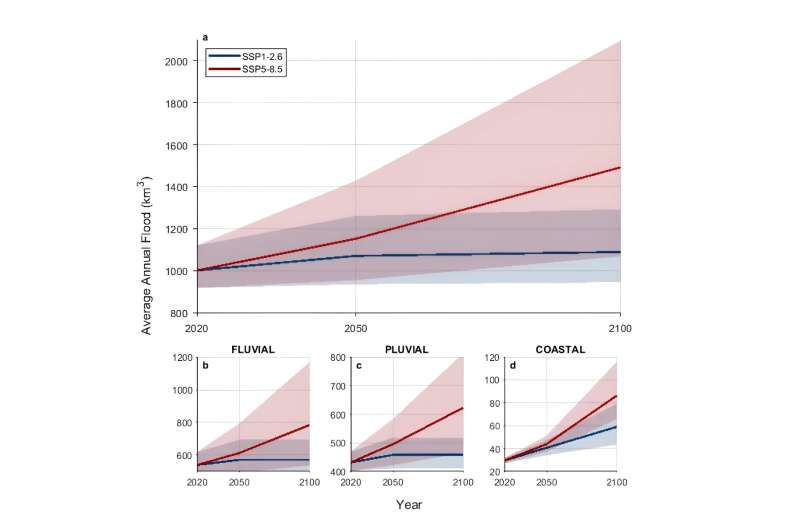
Pioneering research forecasts that worldwide flooding is likely to be significantly worse in future decades if countries fail to meet official pledges to cut carbon emissions.
The study, published in Water Resources Research and led by experts from the University of Bristol and global water risk intelligence firm Fathom, reveals projections of different types of flooding in various climate change scenarios with unprecedented precision.
Through deploying the most comprehensive mapping framework, findings indicate overall global flooding could increase by around half between 2020 and the turn of the century in the event of high climate sensitivity and multilateral promises to reduce carbon emissions being broken.
Lead author Dr. Oliver Wing, Honorary Research Fellow at the University of Bristol Cabot Institute for the Environment and Chief Research Officer at Fathom, said, “This research represents the culmination of years of research on our quest to help future-proof communities around the world from the evolving risk of flooding. The findings underscore the vital importance of all countries keeping their promise to cut carbon emissions.”
In the best-case lower emissions scenario, where all global carbon pledges are fulfilled, the average flood hazard level is projected to rise by 9% between 2020 and 2100. The more pessimistic prospect of higher carbon emissions showed flooding could increase 49% by the end of the century.
In the next few decades, the projected increases in flood hazard were more modest. Between 2020 and 2050, in a low carbon emissions scenario, flood risk is anticipated to grow 7% with this doubling to more than 15% in a high carbon emissions model.
Dr. Wing said, “It is important to note that these global averages result from predicted changes in hazard that have large geographical variations. Some places will see their flood risk fall, while for others the increases will be many times larger than the global average even under a lower emissions scenario.”
The report highlighted that coastal flooding remains a hotspot regardless of whether all global carbon emissions are met or not. Even in a low emissions scenario, coastal flooding is forecast to almost double, increasing by 99% by 2100, due to the lagged response of ocean sea level rise to existing warming.
Flooding caused by rainfall was found to be especially vulnerable to human-induced climate change. Whereas this type of flooding was shown to increase by 6% by 2100 in a low emissions scenario, this increase grows to 44% in a high emissions model.
The largest future increases in flooding are projected to be around global coastlines and in tropical Africa and Asia, as well as significant changes to arid North Africa. The likelihood of flood increases was most pronounced along the North Atlantic and Indian Ocean coasts, as well as for southeastern Asia and the Pacific Islands.
Recently developed global flood models estimate the national or global population exposed to floods; potential value of assets at risk; cost and benefits of flood defenses, and the impact of climate and socio-economic change on future losses. Most only represent river flooding, but this study factors in the significant impact of coastal flooding, and has undergone the most rigorous validation of any global flood model to date.
Countries signed up to ambitious pledges to lower carbon emissions at COP27, and the study clearly indicates that if these aren’t all achieved on time and in full, flooding levels look set to be heavily impacted.
Co-author Professor Paul Bates CBE, Professor of Hydrology at the University of Bristol Cabot Institute for the Environment and Chairman and Co-founder of Fathom, said, “Undertaking this research project involved subjecting our findings to the most comprehensive benchmarking of global flood modeling yet published.
“With the highest resolution results produced to date, we hope industries will derive value from our model for a range of additional use cases, such as protecting critical infrastructure from future flooding, helping insurers price premiums and meeting the requirements of climate regulations.”
Additional contributors to the research paper from the University of Bristol include Prof Jeff Neal, Professor of Hydrology at the University of Bristol Cabot Institute for the Environment and Chief Scientific Advisor at Fathom; and two Fathom scientists soon to embark on Ph.D.s at the University.
More information:
Oliver E J Wing et al, A 30 m global flood inundation model for any climate scenario, Water Resources Research (2024). research-information.bris.ac.u … any-climate-scenario
Citation:
Research shows reducing future global flooding hinges on cutting greenhouse gas emissions (2024, August 21)
retrieved 21 August 2024
from https://phys.org/news/2024-08-future-global-hinges-greenhouse-gas.html
This document is subject to copyright. Apart from any fair dealing for the purpose of private study or research, no
part may be reproduced without the written permission. The content is provided for information purposes only.

